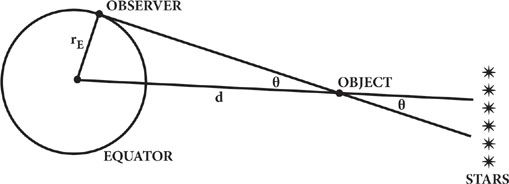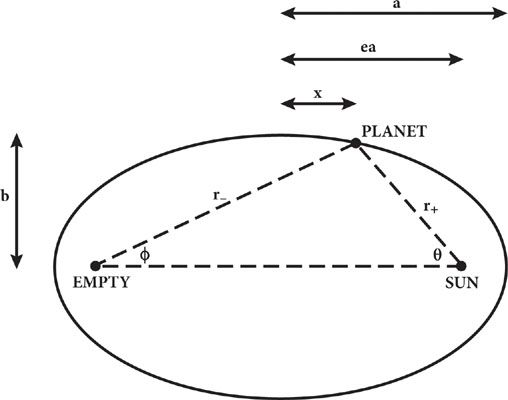To Explain the World: The Discovery of Modern Science (50 page)
Read To Explain the World: The Discovery of Modern Science Online
Authors: Steven Weinberg


Figure 14. Use of diurnal parallax to measure the distance
d
from the Earth to some object.
Here the view is from a point above the Earth’s north pole. For simplicity, the observer is supposed to be on the equator, and the object is in the same plane as the equator. The two lines separated by an angle
θ
are the lines of sight to the object when it just arises above the horizon and six hours later, when it is directly above the observer.
21. The Equal-Area Rule, and the Equant
According to Kepler’s first law, the planets, including the Earth, each go around the Sun on an elliptical orbit, but the Sun is not at the center of the ellipse; it is at an off-center point on the major axis, one of the two foci of the ellipse. (See Technical Note 18.) The eccentricity
e
of the ellipse is defined so that the distance of each focus from the center of the ellipse is
ea
, where
a
is half the length of the major axis of the ellipse. Also, according to Kepler’s second law, the speed of each planet in its orbit is not constant, but varies in such a way that the line from the Sun to the planet sweeps out equal areas in equal times.
There is a different approximate way of stating the second law, closely related to the old idea of the equant used in Ptolemaic astronomy. Instead of considering the line from the Sun to the planet, consider the line to the planet from the
other
focus of the ellipse, the empty focus. The eccentricity
e
of some planetary orbits is not negligible, but
e
2
is very small for all planets. (The most eccentric orbit is that of Mercury, for which
e
= 0.206 and
e
2
= 0.042; for the Earth,
e
2
= 0.00028.) So it is a good approximation in calculating the motions of the planets to keep only terms that are independent of the eccentricity
e
or proportional to
e
, neglecting all terms proportional to
e
2
or higher powers of
e.
In this approximation, Kepler’s second law is equivalent to the statement that the line from the empty focus to the planet sweeps out equal
angles
in equal times. That is, the line between the empty focus of the ellipse and the planet rotates around that focus at a constant rate.
Specifically, we show below that if is the rate at which area is swept out by the line from the Sun to the planet, and
is the rate at which area is swept out by the line from the Sun to the planet, and (dotted phi) is the rate of change of the angle
(dotted phi) is the rate of change of the angle
ϕ
between the major axis of the ellipse and the line from the empty focus to the planet, then

where
O
(
e
2
) denotes terms proportional to
e
2
or higher powers of
e
, and
R
is a number whose value depends on the units we use to measure angles. If we measure angles in degrees, then
R
= 360° /2
π
= 57.293 . . . °, an angle known as a “radian.” Or we can measure angles in radians, in which case we take
R
= 1. Kepler’s second law tells us that in a given time interval the area swept out by the line from the Sun to the planet is always the same; this means that is constant, so
is constant, so
ϕ
is constant, up to terms proportional to
e
2
. So to a good approximation in a given time interval the angle swept out from the empty focus of the ellipse to the planet is also always the same.
Now, in the theory described by Ptolemy, the center of each planet’s epicycle goes around the Earth on a circular orbit, the deferent, but the Earth is not at the center of the deferent. Instead,
the orbit is eccentric—the Earth is at a point a small distance from the center. Furthermore, the velocity at which the center of the epicycle goes around the Earth is not constant, and the rate at which the line from the Earth to this center swivels around is not constant. In order to account correctly for the apparent motion of the planets, the device of the equant was introduced. This is a point on the other side of the center of the deferent from the Earth, and at an equal distance from the center. The line from the equant (rather than from the Earth) to the center of the epicycle was supposed to sweep out equal angles in equal times.
It will not escape the reader’s notice that this is very similar to what happens according to Kepler’s laws. Of course, the roles of the Sun and Earth are reversed in Ptolemaic and Copernican astronomy, but the empty focus of the ellipse in the theory of Kepler plays the same role as the equant in Ptolemaic astronomy, and Kepler’s second law explains why the introduction of the equant worked well in explaining the apparent motion of the planets.
For some reason, although Ptolemy introduced an eccentric to describe the motion of the Sun around the Earth, he did not use an equant in this case. With this final equant included (and with some additional epicycles introduced to account for the large departure of Mercury’s orbit from a circle), the Ptolemaic theory could account very well for the apparent motions of the planets.
Here is the proof of Eq. (1). Define
θ
as the angle between the major axis of the ellipse and the line from the Sun to the planet, and recall that
ϕ
is defined as the angle between the major axis and the line from the empty focus to the planet. As in Technical Note 18, define
r
+
and
r
–
as the lengths of these lines—that is, the distances from the Sun to the planet and from the empty focus to the planet, respectively, given (according to that note) by

where
x
is the horizontal coordinate of the point on the ellipse—that is, it is the distance from this point to a line cutting through the ellipse along its minor axis. The cosine of an angle (symbolized cos) is defined in trigonometry by considering a right triangle with that angle as one of the vertices; the cosine of the angle is the ratio of the side adjacent to that angle to the hypotenuse of the triangle. Hence, referring to Figure 15,

Figure 15. Elliptical motion of planets.
The orbit’s shape here is an ellipse, which (as in Figure 12) has ellipticity 0.8, much larger than the ellipticity of any planetary orbit in the solar system. The lines marked
r
+
and
r
–
go respectively to the planet from the Sun and from the empty focus of the ellipse.
